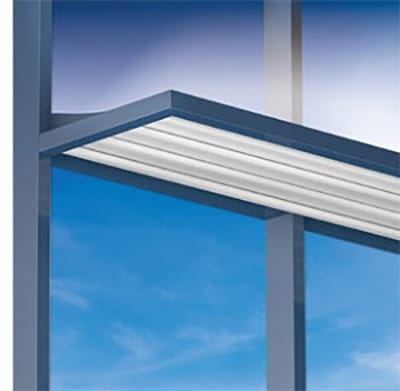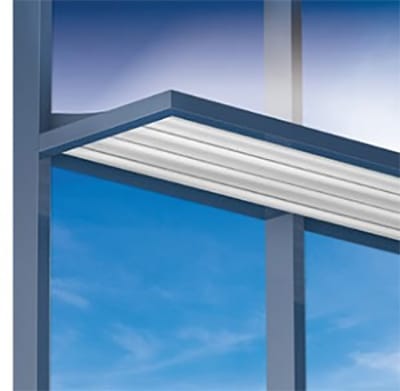How Sunshades can Reduce HVAC Costs and Improve Building Aesthetics
Buildings with large glass curtain walls offer vibrant interiors full of natural light that can help boost occupant morale. So it’s no wonder the use of glass in building enclosures has grown significantly over the years.
But there’s a dark side to too much natural light: direct sunlight, especially in hotter climates, can wreak havoc on utility bills because of the stress it puts on air conditioning systems. Fortunately, there are strategies you can employ to get the benefits of natural light while controlling energy costs. This article explores one way to do just that.
An Introduction to Sunshades
Sunshades are increasingly being used to reduce heating, ventilation, and air conditioning (HVAC) costs and increase the overall comfort for building occupants.
When we talk about sunshades for buildings, we’re referring to metal (usually aluminum) components that are attached to commercial windows to help shade the window from direct sunlight. However, not all sunshades are alike: there are many design options (shape, material, static vs. dynamic, etc.) that impact the performance and cost-effectiveness of sunshades.
The most typical sunshade is a metal louver made of extruded aluminum, but sunshades can be custom-designed to match or contrast with the curtain wall material and design. Extruded aluminum is the most common material choice because of its versatility; machinability; light weight; high stiffness; resistance to thermal expansion; smooth, easily coatable surface; and high corrosion resistance. Aluminum is also a sustainable material choice because it is relatively easy to recycle.
Other materials such as steel and precast concrete can also be used to create a different aesthetic. It really depends on what works best with the design of the rest of the building.
The Benefits of Sunshades
There are many benefits associated with adding sunshades to your design. Most importantly, they:
- Help mitigate solar heat gain to reduce energy consumption from HVAC systems, and
- Enhance aesthetics by adding visual depth.
These two benefits will be the focus of this article. But you should also note other important benefits, such as creating a more comfortable interior environment for occupants, reducing glare, and protecting glazing from harmful UV rays.
The Benefits of Sunshades
There are many benefits associated with adding sunshades to your design. Most importantly, they:
- Help mitigate solar heat gain to reduce energy consumption from HVAC systems, and
- Enhance aesthetics by adding visual depth.
These two benefits will be the focus of this article. But you should also note other important benefits, such as creating a more comfortable interior environment for occupants, reducing glare, and protecting glazing from harmful UV rays.
How Sunshades Reduce Solar Heat Gain
In the northern hemisphere, sunshades are commonly installed on south-facing walls to block the summer sun’s rays when they’re at their strongest. Sunshades can be strategically positioned to maximize their effect when the sun is at its highest point in the sky (at midday). The direct impact of such a design is to increase the overall energy efficiency of the building. But it also increases occupant comfort by preventing rapid heat gain near windows and reducing glare that can be very distracting.
A typical sunshade system projects 3 feet from the top of a window or glass span. This ensures that plenty of natural light can enter the building when the sun is relatively low in the sky — especially during the winter, when the sun follows a lower path and its warmth is welcomed to reduce the load on heating systems. The result is a year-round boost in energy efficiency. Of course, this 3-foot span won’t be applicable for every building. The overhang distance has to be adjusted based on the project’s geographic location and other factors. A design optimized for conditions in New York will not work as well in Nevada, for example.
It’s also important to note that sunshades, beyond being used to shield windows, can also be used to reduce heat gain on walls, air intakes, and air conditioning units. Anything that needs to stay cool to work efficiently can benefit from the protection of sunshades. They can also be installed on the east or west side of a building. However, the priority is typically the south side because peak cooling demand coincides with the hottest part of the day, when the sun is high in the southern sky. This is also when electricity is most expensive to produce and consume (many utilities charge higher rates at midday from May to September to help cover the costs of the electrical generating stations needed to meet this peak demand).
Today, most sunshades are passive: they don’t change orientation based on the sun’s movement. But it’s also possible to use active sunshades that track the sun to optimize the amount of sunlight entering the building at any time. Other designs, called sun shelves, actually direct natural light further into occupied spaces, which creates a more pleasing and uplifting environment by spreading natural light more evenly into the building interior.
Sunshades Improve Aesthetics by Adding Depth and Dimension
Sunshades do even more than provide practical, quantifiable benefits: they also look great! Of course, sunshades will only improve a building’s aesthetics if they complement, not clash, with the design intent of the building envelope.
Sunshades improve building aesthetics because they add dimension and depth to just about any design. In fact, sunshades were initially referred to as “eyebrows” because of the way they can add dimension and style to a flat surface. They were originally considered more aesthetic than functional. And, ironically, when a building owner wanted to reduce costs, they were often one of the first products pulled from the design. In fact, sunshades only recently (~2007) started being appreciated for their energy efficiency-boosting features. Designers quickly learned that “eyebrows” can do a lot more than just look good.
Today’s designer in the market for sunshades has many options. Sunshade manufacturers offer custom designs and complete control over material and style. For example, you can choose between an in-rigger or outrigger installation — and if you choose outrigger, you then have more options such as square, bullnose, and tapered. You can also choose between different blade styles like rectangular, square, round, or even airfoil; or you can choose a single-blade design. And, finally, you can customize the finish of your sunshades with powder-coat paint, Kynar coatings, or RAL paints.
Quantifying the Cost Savings
While sunshades increase upfront costs, this increase is offset over the life of the building through savings in energy costs and reduced wear on HVAC systems. Designers can minimize the upfront cost of sunshades by choosing a cost-effective material like extruded aluminum and an efficient and effective design that minimizes solar heat gain.
However, HVAC costs aren’t the only consideration: lighting accounts for 40 percent of the energy used in a typical commercial building. A design that maximizes the use of natural light while limiting solar heat gain can significantly reduce electricity demand for lighting (and the associated waste heat produced by most bulbs).
So how much energy can you actually conserve by using sunshades? A study from the University of Minnesota (The impact of external shading devices in commercial buildings) compared energy savings from sunshades on south-facing walls in various U.S. cities and found energy savings of 27 percent in Los Angeles, 25 percent in Houston, and 22 percent in Chicago. In general, there’s more benefit to sunshades in hotter climates.
However, location is not the only variable. Energy savings also hinge on the size of the windows, the design of the sunshade, the length of its overhang, and the type of window glazing employed. To determine potential energy and cost savings for a particular project, you can use energy modeling tools such as COMFEN, developed by the Department of Energy’s Berkeley Lab.
There are also new technologies on the market that can be integrated into your design to boost your return on investment, like photovoltaic cells that allow sunshades to generate electricity and automated shades that adapt to the movement of the sun and even retract when they’re not needed. These technologies will add to your upfront cost, but in certain scenarios may be cost-effective in the long run.
Finally, another important benefit of incorporating sunshades into your design is that they help with qualifying for LEED certification. Since sunshades help reduce energy consumption, they qualify for LEED points under Energy and Atmosphere 1-Optimize Energy Performance. But that’s not all: if you choose aluminum sunshades, you can also score points under Material and Resources 4.1-Recycled Content.
Being LEED-certified introduces several potential benefits, such as faster lease-up rates, higher property values, and, in some jurisdictions, tax rebates and zoning allowances.
Conclusion
Hopefully by now the benefits of sunshades are clear (mitigating solar heat gain, reducing energy consumption, creating a more comfortable environment, protecting glazing from harmful UV rays, and improving aesthetics). But in order to realize these benefits, you need to employ a design that fits with the rest of the building.
Working directly with a trusted manufacturer will allow you to specify the best sunshade system to meet the performance and aesthetic requirements of your project. We choose Tubelite as our partner for sunshade products because of their longstanding position in the business (since 1945) and proven expertise. Their website has tons of in-depth information for further reference, including product design manuals, technical specifications, and a gallery where you can get inspiration from several real-world examples.
One final note: keep in mind that when designing energy-efficient building envelopes, sunshades are only one part of the equation. They should be used in conjunction with low-E insulating glass and thermally broken fenestration systems for optimal performance.

Tubelite’s Light Shelves reduce the need for artificial light by directing light deeper into occupied areas.

